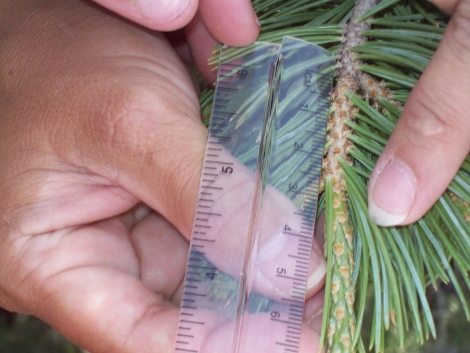Optional Field Research Task
For those who have a stand of Pinyon Pine in your area, this is a real research opportunity! Follow the steps below and record your own data for this investigation.
Materials Needed:
- Data Recording Sheet print out
- Flagging (available at any sports store, hunters use it to mark their favorite trails)
- Permanent markers
- Clipboard for each group
- Pencils
- Rulers with Centimeter and Millimeter markings
- Counters (optional)
- Hand held GPS (optional)
- Tape measure (cloth type is best, available in FOSS kits if you have them)
- Plastic containers (film vials, baggies)
- Small mailing envelopes, 1 large manila envelope
- Dissecting microscopes (check with your local Middle School if you don’t have one. Microscopes must have a top light to see the scale.)
Step 1
Identify a stand of 5-10 trees.
Step 2
Flag the trees so that you can find them again. Number your trees on the flag with the permanent marker. If you have a GPS with you, note the position next to the tree number. Make sure that each group has their own number(s) so there is no duplication.
Step 3
Measure 8 stem growths from your tree. Check out the pictures to see how to measure stem growth. Make sure you take measurements from high, low and all around the tree. The best time
for measurements is August to September for the current year’s growth. In the Spring, we measure for last year’s growth. If in the spring, we measure the part of the stem that has the tan coloring. The green stem at the end is new growth that has not finished growing for the year. If stem measurements are taken in October, the end portion would be recorded.

Step 4
Take a trunk circumference measurement. Measure at the base of the trunk, just above the ground. Give an approximate height of your tree and record whether it is healthy, dying, might have scale (remember what a scale infected tree looks like).
Step 5
Count the strobili on your tree and the cones on your tree. Depending on the time of year and the maturity of the tree, you might not have these. May to June is best for strobili depending on whether you live in a higher or lower elevation. August to September is best for cone counts.

Step 6
Take 30 needles from each tree and put in a plastic container. Mark each container with its tree identification number. Randomly choose 10 needles to examine under the microscope. Record whether you see any evidence of scale on your data sheet. (Check out the pictures to see what you are looking for.) Scale will appear on a needle as black ovals, some flat up to rounded bean shapes. Sometimes the shell will be completely burst open or opened at one end. This means the scale insect has emerged.

Step 7
Find the mean stem measurement for each tree. Enter the measurements into a spreadsheet on Excel. Save the spreadsheet for further use. This activity can be used for a number of years so that the data can be analyzed and compared to your climate data to determine whether any climate change is effecting the Pinyon Pine in your area.
Step 8
Save all your data and notes for use in Predictions and Solutions and your final project.